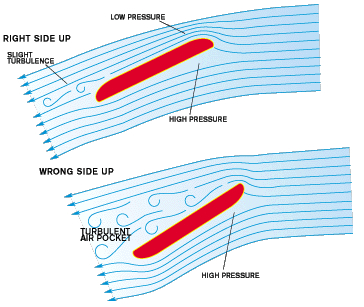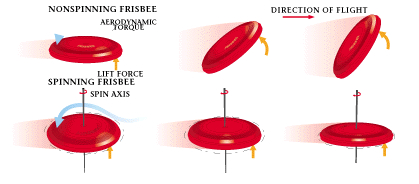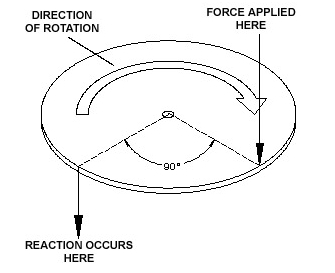When looking at the flight characteristics of frisbee's there are a few basic principles that must be taken into consideration. These principles are aerodynamic lift, Bernoulli's principle, Newtons third law, angular momentum, and gyroscopic stabilization.
Aerodynamic Lift
There are some controls on the aerodynamics of a Frisbee. One control is the deep lip. This lip controls the pitch moment so that it retains managable values. The second control is the thickness of the plastic that comprises the Frisbee. The thickness of the plactic varies across the disc. Most of the Frisbee's mass is concentrated at the edges making a thick lip. This distribution of mass maximizes the moment of inertia resulting in a flight patern similar to that of a spinning flywheel.
Affects of the angle of attack on the trailing air during disc flight

Bernoulli's Principle
Bernoulli's principle states that moving air has less less pressure than still air. This can be related to a Frisbee's flight because when air travels over the curved top surface of a disc it is traveling faster than the air below. This creates low pressure on top of the disc and high pressure below. This is the main principle that drives lift. The image below is representative of the flight characteristics of a Frisbee thrown both rightside-up and upside-down.
Graphical representation of Bernoulli's Principle

Newton's Third Law
Newton's third law when relating to a Frisbee's flight is very similar to Bernoulli's principle. Newton's third law states that with every action force there is an equal and oppsite reaction force. The Frisbee is able to fly due to the fact that when a Frisbee flys it forces air downward and the air forces the disc upward.
Angular Momentum and Gyroscopic Precession
People are capable of controlling the flight that a Frisbee takes. This is due to the implementation of angular momentum and gyroscopic precession. When someone throws a Frisbee they impart spin on the disc, this gives the Frisbee more angular momentum which in combination with gyroscopic precession stabilizes the disc during flight. The more spin you impart when throwing a Frisbee the longer and more stable the disc will fly. The angle and pitch at which you throw the Frisbee at also affect the flight pattern. If you throw a Frisbee slightly tilted it will follow that pattern until it hits the ground. This is characteristic is also controlled by gyroscopic precession.
Comparison between spinning and non-spinning discs

The phenomenon of gyroscopic precession

The precessional frequency is represented by the equation courtesy of blaze labs research:
wp = (Frsinθ) / Iw
where
w is the angular velocity of rotation
wp is the precessional frequency
F is the external influence force acting on the gyro
r is the distance at which force F is acting from the spinning axis
I is the moment of inertia of the gyro
θ is the angle which force F makes with the spinning axis
